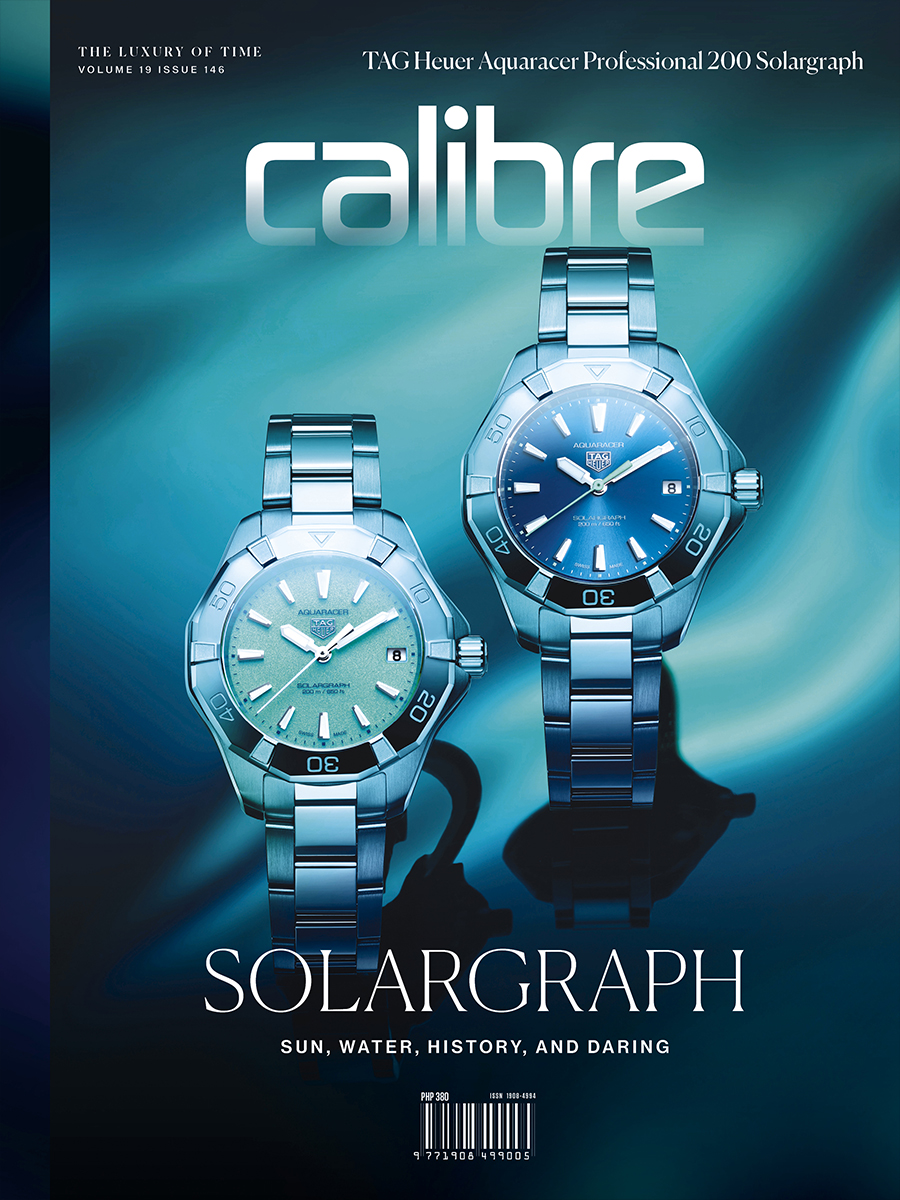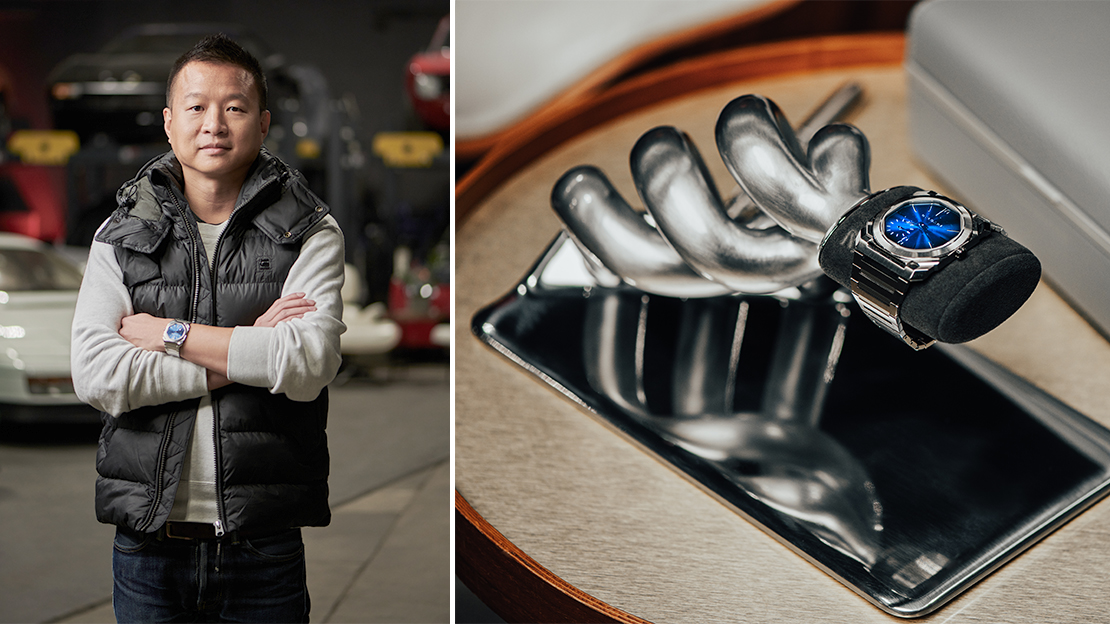For more information about R Werk TYP-01, click here.
Calibre: Who are you?
Nelson Wu: I’m Nelson, and I’m a car and a watch enthusiast.
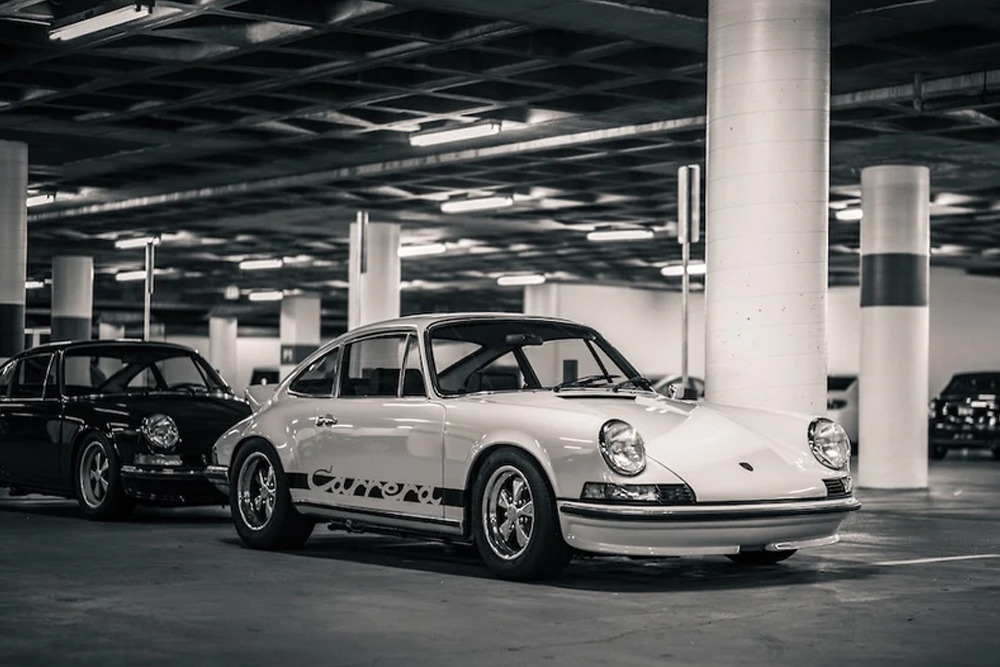
This image from https://r-werk.com/
A CAR ENTHUSIAST
Calibre: Let’s take those in order. Going back to the beginning, what first sparked your love of cars? Was it a family member, or a visceral reaction as a child seeing a sports car?
Wu: As a young, impressionable boy… I guess that’s why Italian cars resonated at first, more than German. When you see a bright red Testarossa driving down, with wide wheel arches, wedge shapes, and the loud exhaust of the flat-12, it’s hard not to let your jaw drop. Particularly when I was little, I’d see these crazy things on the street, and they left a big impression.
Calibre: Where did your love for Porsche come from?
Wu: When I grew up in Toronto, I actually never liked Porsche all that much. It was always the Italian exotic cars that were a little more captivating for me at the time. You would get the more extroverted designs—the flares, the wedges, the passione and emozione! It’s really when I moved to California about 15 years ago, because of my career, which exposed me to Porsche. I was able to experience all the different nuances of Porsche sports cars through the years. I got to know owners, enthusiasts, and even people that are now part of Porsche racing history. And through their experiences, learn a little bit more about the car. It’s because of that that my passion for Porsche sports cars, and the 911 in particular, grew quite a bit over time.
Calibre: Why is the 911 specifically so appealing?
Wu: The thing that appeals to me the most about a Porsche 911 is that it’s a design that‘s been iteratively improved for more than half a century. Being inside one, the layout, the control, the fit is all honed over time. As an engineer, this was something that is endlessly fascinating for me. And the other thing that I quite like about 911 is this duality of the product. On one hand it’s a reliable, practical car for people to use on a daily basis. But once you want to push it a little bit as a sports car, it is incredibly exciting, extremely communicative, and very satisfying to drive closer to the limit. This combination is not something you really see on other cars.
Calibre: Even more specifically, why the 1973 Carrera RS?
Wu: To me, the ’73 Carrera RS 2.7 is basically 911 distilled. I feel that it’s the one product that explains the allure so well. On the face of it, the Porsche made the 2.7 RS for homologation in its racing program at the time, and they went on to achieve quite a bit of success. But if you were to buy a 2.7 RS and opt for a Touring pack, it’s a perfectly suitable car for a cross-country, intercontinental drive as well. And naturally a lot of the spirit of the 2.7 RS lives on—the ducktail, the lightweight philosophy.
Calibre: You mentioned that your real introduction to Porsche came after your move to California. Did you find that a lot of the attraction for the brand came from the personalities? Do you find that you’re drawn to companies, products that make their personalities available to you?
Wu: Over the last many years, one of the things I spend a lot of time thinking about is what passion means, and what it means to me personally. And how I go about exploring my own passions and what makes me like certain things. I realize that what intrigues me, fascinates, mesmerizes me is all about story. I didn’t have the exposure to that until California, where it was much more accessible to learn about these stories from different peoples’ perspectives. They allowed me to peek and understand the nuances, and that’s ultimately what drew me further into the brand.
Calibre: Do you think that passion will continue as we switch to EVs, and drop 2L 4-cylinders into every car?
Wu: Maybe, although frankly, I don’t care. When it comes to new car products, we are in a transition period, anyway—halfway into the future with full electric, or whatever alternative propulsion energy, and halfway in the past with internal combustion. As an engineer, I understand that during transition it is all about the management of compromises. Truth be told, all the cars that I grew up loving, they’re all out there. So whether or not I continue to be fascinated, or feel the same amount of passion that I once had for older cars toward newer cars? To me, it’s irrelevant. I’m more than happy with the fact that, looking back, there are so many interesting cars. I can cherry-pick the ones that really resonated with me, and hopefully have the opportunity to experience them personally, instead of only learning about them through magazine articles and VHS tapes. As far as the future goes, it’s not something I spend too much time thinking about.
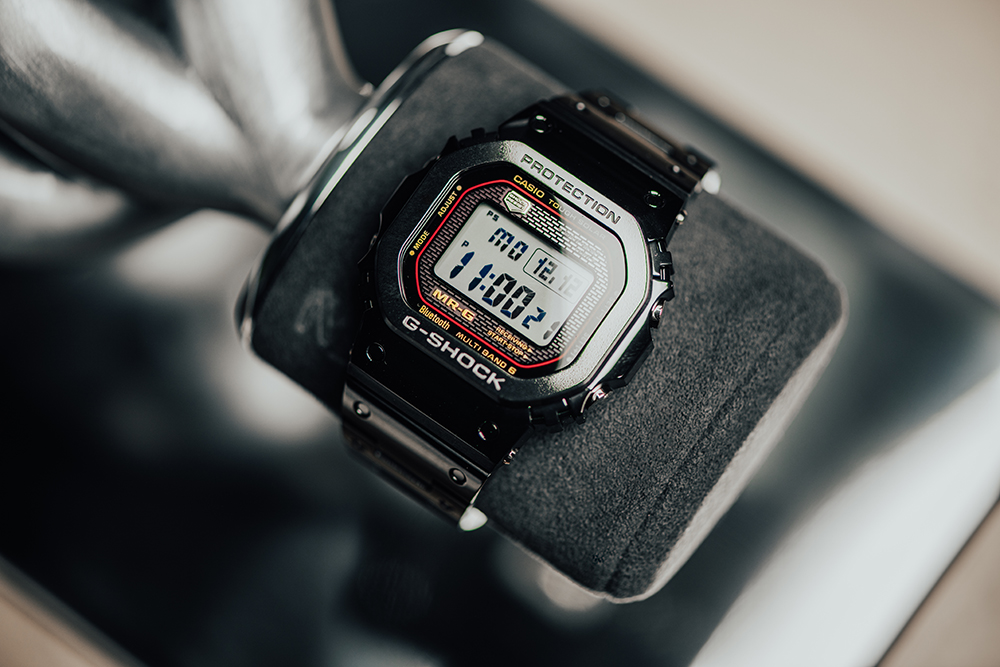
A WATCH ENTHUSIAST
Calibre: Now jumping into the world of watches. In this world, we obviously don’t have that same feeling of apocalypse. It doesn’t feel like anything’s about to come to an end.
Wu: Well, we already passed beyond that point with the Quartz Crisis, and now we reemerge and people appreciate watches in different contexts, rather than being all about the pursuit of precision and timekeeping. Now we are able to have a more open mind to appreciate mechanical engineering, craftsmanship, and aesthetic design. Maybe we’ll go through the same thing with cars in a couple of decades.
Calibre: What is the appeal of watches?
Wu: To me a watch is something that is deeply personal. As an engineer, the idea of having something that is so overwhelmingly complex mechanically, yet is there to deliver a very simple, elegant function… it’s so fascinating. I’m also mesmerized by this idea of machine/human tactile interaction. That’s something that we get from watches. Obviously, when you wind it up every day, you build that relationship with a watch.
Calibre: What watch or upcoming watch excites you most right now?
Wu: The watch that has excited me quite a bit lately… They’re a couple of pieces from A. Lange & Söhne. I guess it’s because of the price point that it occupies, and the relative scarcity of the brand. It’s not easily accessible or something you easily see out in the wild. The more I study it, the more I learn about the brand. The more I feel the same as when I learned more about Porsche. It obviously has a rich history, though there is that period of time when they halted operations. But ever since it restarted, it’s able to fast-track development and push so much forward, in terms of dial aesthetic design, the movement finishing—how architectural and three-dimensional they all look. It’s one of those things that is not immediately obvious when looking at pictures. But when I handled them in person, it is very inspiring. The other thing I felt inspired by is ALS’ attention to detail—the typefaces put on the dial. On the 1815 Chronograph or the Datograph, the dial portrays so much information and is able to leverage the typefaces and lay out all the information in such a balanced, legible way. It’s quite impressive, and something I think about constantly.
Calibre: I’m going to be jumping back and forth between watches and cars. Is there a particular automobile’s cockpit or dashboard that has a similar attraction to you in terms of layout and typefaces?
Wu: When I’m in the car and driving, I’m less focused on the steering wheel and dash. Having said that… In terms of interior, I do remember growing up—in the back seat, riding with my grandfather, in his 560 SEL. The interior, the leather, the lighting on the dash, the huge buttons. I didn’t expect to give you this answer, but thinking about the interior—what left the biggest impression on me was that.
Calibre: You’re familiar with the term “Proustian memory”? (He is not.) If you’ve seen the ending of Ratatouille, where the critic takes one taste of the ratatouille… Suddenly he’s transported to a different time and place. What do you think is the trigger in your memory of your grandfather’s SEL? How much of that is visual, tactile, even the smell..?
Wu: It’s the smell. There’s a distinctive smell of Mercedes from the 80s. There was so much leather in there that whenever there’s some temperature or humidity, you could really smell it. It was extremely lavish how they used it and wood back in the day.
Calibre: I’m very partial to glossy walnut from the W123 and W124, as nice as the modern open-pore ash is. Did you have any other watches beyond ALS that appeal to you?
Wu: For ALS, I’m also fascinated by the 1815 because it’s a manual-wound, column-wheel chronograph and that everyday human/machine interface. The other piece is the Vacheron Constantin 1955 Historques Cornes de Vache 1955. Similarly, a manual-wound chronograph with a Lemania-based movement, column-wheel, with a distinctive case design. I guess I’m a car guy as well, so the fact that both pieces are chronographs probably has something to do with that.
THE PASSION BEHIND THE WORK
Calibre: Let’s get to the meat of the matter: TYP-01 from your company R Werk. What is the impetus? A lot of guys have a passion for watches and cars. It’s not uncommon, it’s like a natural pairing. But I’ve never met anyone who said, “I need to express this.” What drives that?
Wu: Let’s rewind by twenty years. Relatively early on, despite my love for cars and watches, I intentionally did not pursue either one of those industries for my career. Looking back it was likely because of the fear that it might dilute or erode the purity of my passion. Now, years later, with the experiences, skills, and expertise that I’ve acquired, and my self-awareness, I feel comfortable and confident that I can pursue my passions, and build a company around this, while keeping my love for watches and cars pure.
But going back to the impetus: As I learned more about what passion means to people: One thing that kept coming up was the idea of a personal symbol. People of faith tend to have religious totems like a cross or a Buddha statue in the home. When they see it, it reminds, reassures, reaffirms their faith. Wedding bands: they’re public symbols of a person’s commitment to their partners. So this idea of a personal symbol—a sculpture which, once completed with my personal watch on the watch rest… It reminds me of the passion I have towards cars, and the passion I have for watches. It reaffirms passion, and the opportunity to invite friends, family, acquaintances to see and experience the piece. It hopefully reminds them or shows them a bit of who I am as a person as well. That’s what drove me to build a product like this.
Calibre: Not to be a smart-ass about it, but someone else might wear a Ferrari T-shirt and a Datejust, and say that these are the things that I’m passionate about. Obviously, there is more of that creative drive in you, so what is the differentiating factor? You mentioned not having the confidence in the past. Has there always been that urge to have something that reflects yourself in a portable, digestible piece?
Wu: I think one other reason is that the career that I’ve pursued up to this point, it’s a career that is not directly about my passion. I am in a passion business, nevertheless: I’m in the business of designing, making, distributing, marketing product that is for people of different passions: Audio equipment for audiophiles, computer peripherals for gamers, photographic equipment for photographers. I think I managed to accumulate a bit of experience interacting with a lot of people who are passionate in their crafts, and in the type of product they’re making.
Whenever I interact with people who are passionate, even if it’s a passion that I don’t share at the moment, I always have a great, fulfilling, invigorating experience. The idea of TYP-01 and R Werk is to use the product as a vehicle to work with people that I long admired and respect, and want to learn from. With R Werk I get to work with Mo, the lead designer for the TYP-01. Through him I learn a tremendous amount on the thinking process when it comes to automotive design. Today, I met with Axelle, who is a papermaker who is passionate about hand-designing paper, and using it as a medium to express her craft. That’s the impetus for R Werk as well. To use this opportunity to collaborate, and push people to push their craft even further, and do something that hasn’t been done before.
Calibre: How did you meet your team members like your lead designer, Mo?
Wu: It was an intentional reach-out. I’d come across several pieces of his work that resonated quite a bit with me. Some of his design projects from school, and some of the pieces he’s done since then. I’ve had interesting conversations since then, and realized that there’s a lot of things –obviously we shared a lot of things in common. But our passion for cars and watches was meaningfully different so that it would cover a lot of bases between him and me. As a result, through his perspective, I was able to learn a lot more about car and watch culture in a way that I wasn’t able to before.
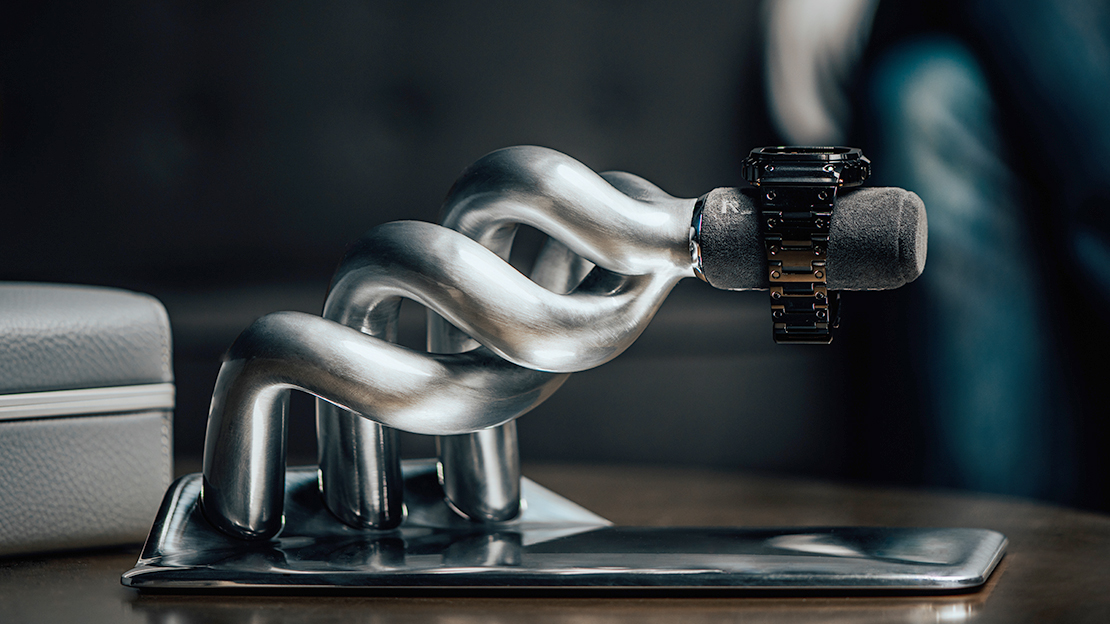
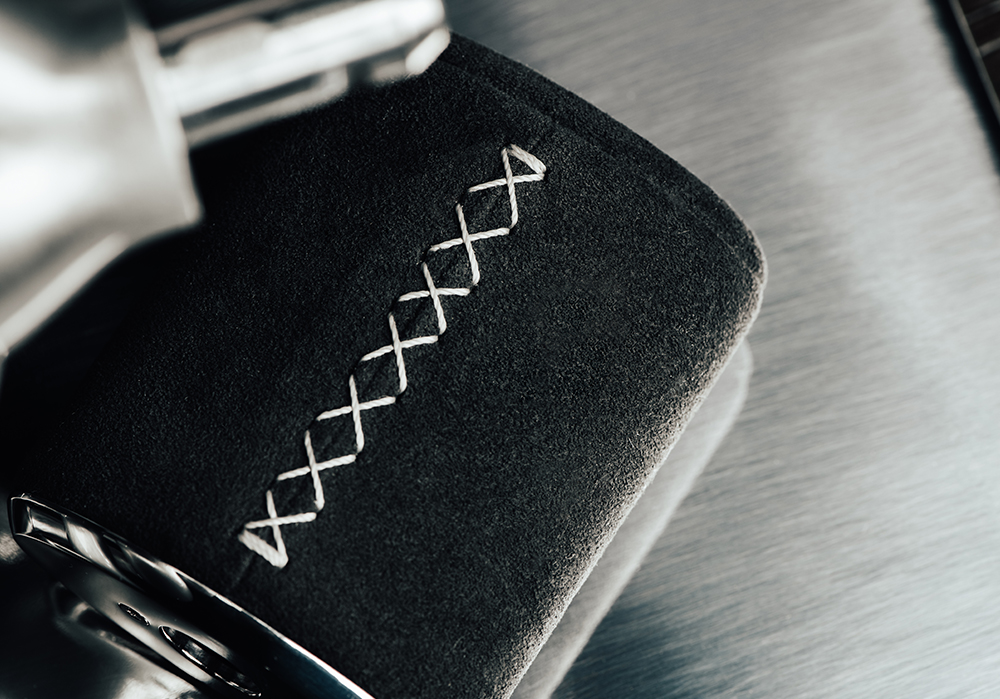
DESIGNING THE TYP-01
Calibre: I’m looking at the TYP-01 in front of me. What are the major influences on the design of this sculpture?
Wu: Let’s get into it! One of the things I realized while working with Mo, and what I finally had the vocabulary to articulate: What resonated with automotive design is that it’s very different from consumer product design or furniture design. Those are mostly a series of surfaces punctuated by corners and lines that connect them together. With automotive design, it’s about usage of very complex surfaces to instill a strong sense of dynamism, athleticism, and motion into an object even when it’s stationary. One thing automotive designers spend a lot of time thinking about is designing a car that even when stationary, it looks ready to pounce. This is something that we try to incorporate into TYP-01. First, we try to make it look like it’s levitating off the surface it’s resting on. The base is seemingly a simple surface on one side. But towards the corner, it starts to become a lot more 3-dimensional, with a kick that’s inspired by the ducktail from the 2.7 RS. This is the foundation for the supporting structure, which is the pipes inspired by the racing header of a 911’s Flat-6 engine. The pipes organically, curvaceously, interact with each other before merging into one. This helps focus attention on the main piece: the watch that you have on the watch rest. Also, the sculpture is cantilevered, with the supporting structure on one end, and that adds a bit of motion to an otherwise static structure.
BUILDING THE TYP-01
Calibre: Can you go into more detail on the various manufacturing processes?
Wu: We employed two types of manufacturing with the chassis and the pipes. The base plate is hydroformed. The chassis [the flat plate that attaches to the base] is made using subtractive manufacturing: We started off with a huge block of 7075 aluminum, and a CNC machine carved out this piece. This pipe is made using additive manufacturing—basically 3D printing. We print one layer of metal at a time, and this piece comprises 7000 layers of metal. Just this piece alone takes more than 20 hours to print. Never mind the finishing, as it’s hand-brushed as it’s quite rough when it first comes out.
Calibre: And the Alcantara shoe for the watch? Is there a special process?
Wu: Yes, it’s made by hand! Alcantara is the material that was chosen because of its history and use in racing applications, such as steering wheels, gloves, and seating. So we found it very appropriate for the TYP-01. It has a high-grip surface and it’s also a great juxtaposition in terms of texture versus the raw metal. It’s also hand-stitched at the bottom using the same stitch pattern as on the 911 GT steering wheel. The Alcantara color is also the same shade of black that you see in Porsche GT cars.
Calibre: Tell me about the screws.
Wu: We definitely spent a lot of time to make sure that we hide ever single fastener in the design. One of the philosophies of the brand is that everything we have, even the things that you don’t see, is bespoke, commissioned and designed by us—down to the screws. The screws are titanium. We designed the screws, we designed the patterns. I was also telling you about Axelle the papermaker. We are commissioning our own paper as well.
Calibre: I think that underlines the point that this is uncompromising.
Wu: It’s very uncompromising. Everything is bespoke, nothing is off the shelf.
Calibre: I’m curious: what is the screw head shape? Is that a secret, and do you need a special screwdriver?
Wu: It’s a slightly tweaked version of hex. I was going to have something that was a little more wild, but I was encouraged to be more restrained by our fastener supplier so that it will be easier for manufacturing and after-sale support.
THE JOURNEY TO PRODUCTION
Calibre: We’ve talked about your journey toward understanding the manufacturing process. What were your biggest lessons learned, and revelations in the process?
Wu: This is a project that I’ve been working on for slightly over a year. For the first 70-80% of the time I approached this as a personal passion project. So money was not something that we actively thought about. It was just: If I have the resources, then push the team to go as far as they can without consideration of manufacturing capabilities, or access to machinery. How far can we push this? Can we keep the philosophy of TYP-01 as pure as it can be, and not dilute it because the cost might be prohibitive? To that end, there are a lot of different things that are self-indulgent in how we manufacture this. The product incorporates a lot of manufacturing techniques—that in itself is rather unprecedented. But as an engineering exercise on one hand, and a passion project on the other, the idea of TYP-01 materialized in the purest way possible.
Calibre: At what point, during your blueprinting of series manufacturing, did you realize, “I do have to consider money. This can’t be unlimited cost.”?
Wu: I’ll counter that with an example. It really was a money-no-object project. If you see the chassis (He pulls out a prototype chassis plate.), it’s not obvious but the chamfer is at a 73 degree angle. In the beginning, we hoped to make this piece using a 3-axis CNC machine, which is more accessible with a price that is not exorbitantly prohibitive. But there was a debate between Mo and I. As a designer who wanted to keep the design as pure as possible, he wanted this to be set at a slight angle so it looked more stable. And also because with this angle, the kick resolves much more gracefully. This is a small detail that pushed us to use 5-axis CNC, which changes the cost profile completely. There’s a long period when I thought about maybe not going that far, and sticking with a 90 degree angle and 3-axis CNC.
But there was a point when I learned about the Singer DLS. I was fascinated by it, as a friend of mine had taken delivery of the car during that time. I had a conversation with him about Rob Dickinson’s design process for the Singer DLS. He would go so far as to request Michelin to make tires with curvature specific to the car. Never mind the compound—those are a dime a dozen. He went so far as dictating the curvature the sidewall just so it lines up with the wheel. So it emphasizes the model of Singer: Everything is important, and you push it that far. Once I learned about that story, I realized that we have to go that far.
INSPIRATIONAL DESIGNERS
Calibre: Let’s go back to personalities. In your interactions with luminaries of the automotive world, which designers have inspired you the most in recent years? (“Aesthetic or engineering?”) Let’s start with aesthetics, and then go into the totality of engineering a car.
Wu: Give me a moment—there’s quite a lot! I think for the more contemporary ones… Frank Stephenson, particularly with his work at McLaren. I’m mesmerized by how he incorporated biomimicry into his design. The cars that McLaren Automotive developed during his time—all of the cars rely heavily on aerodynamics. It’s hard to think of any classically beautiful design that leaned in heavily to aerodynamics. With aero there’s a lot of appendages and devices that are certainly functional, but not necessarily beautiful. With Frank Stephenson, particularly at the end of his tenure at McLaren and the P1… It is obviously a car that is shaped by air, but he is able to make it in a flowing way that is so distinctive. Alien-like. There is always an aspect of awkwardness in a piece of art, but there is a cohesion that is organic and beautiful, that I don’t see in other aero cars such as the later GT3RS or the Senna.
Calibre: Whole-package engineers: Who has inspired you, whether it’s for R Werk or for an approach to life and business in general?
Wu: That’s a seemingly difficult question with a very easy answer: Professor Gordon Murray. Ultimately, it was Prof. Murray that made me feel fascinated about mechanical engineering that led me to pursue engineering in university. Never mind his accolades and achievements in Formula 1, or even his accomplishments with the McLaren F1. Watching how he articulates his engineering ideas, and is able to distill seemingly complex ideas into a very easy-to-understand concept. At a younger, more impressionable age, it allowed me to understand what engineering was about so much more than any other media exposure that I had. Secondly, he is a first principles thinker. With whatever objective he is trying to engineer towards, he is relentless in his pursuit with regard to material engineering, etc. So he comes up with a lot of clever ideas to solve interesting problems. Later in life I had the opportunity to meet with him a couple of times, and it reinforced my love towards engineering, toward cars.
DESIGNING INSPIRATION
Calibre: You’re making 399 pieces of the TYP-01. Do you picture a particular type of person or personality that would be most suited to it?
Wu: Easiest way to answer it on the surface: Someone who likes cars and watches. But to me, this project is a lot of things for a lot of different t people. One of the key takeaways is that when you have a collection of passionate people that care a lot about their craft, we can have a special product like this, and that’s an inspiration for them to do something themselves. Hopefully, we have people that are passionate in different things, and think about the idea of personal symbols. Maybe their symbol is not the TYP-01, but maybe they can make something that is the distillation of their passion. Or maybe people who resonate with the story that I’m telling, resonating with cars, Porsche, and watches, and want a functional sculpture that not only is a great place to rest their timepieces, but also a great display that they can keep in their home, in their office, in the corner of the bedroom.
I guess this is a good way to go back to an early point I mentioned: This is a vehicle for collaboration and inspiration. I want to sell an experience, and allow people to have full trust in the creators’ vision and execution. It’s like when you go to a perfect resort, and you know that no matter how much more money you spend, the experience you have at that moment could not be improved. It takes very little to break that spell, so it is crucial to be uncompromising.
Calibre: Final question about the way you named it: TYP-01. You’ve established all of these great connections with designers, craftsmen, metallurgists, other specialists. You have this apparatus now at R Werk. What comes next? Do you already have sketches for a TYP-02?
Wu: I don’t. Truthfully, I don’t. Take it a couple of steps back. The philosophy for the brand: The mission statement is to continuously explore, design and produce beautifully-crafted objects that sit at the intersection between automotive engineering and horology. And hopefully, if TYP-01 resonates with people out there, and they’re willing to give us more resources to go further down this path… I’m sure there are a lot of different things that we can come up with.

